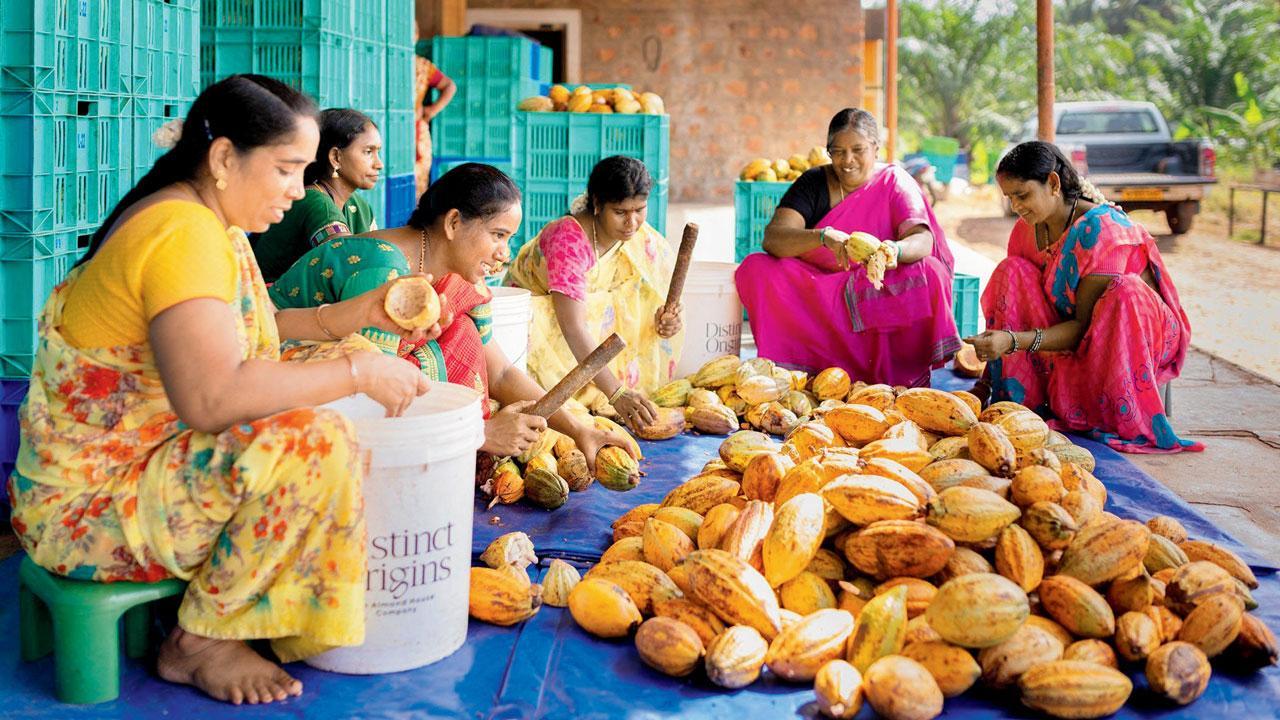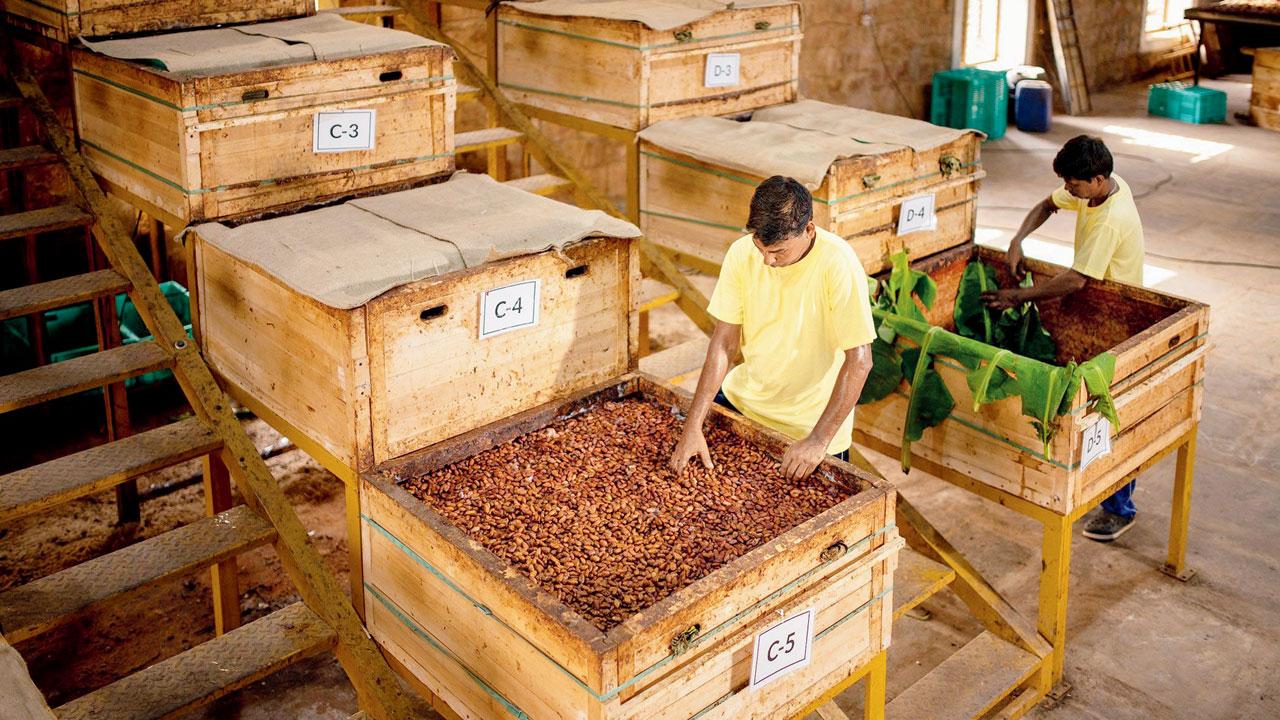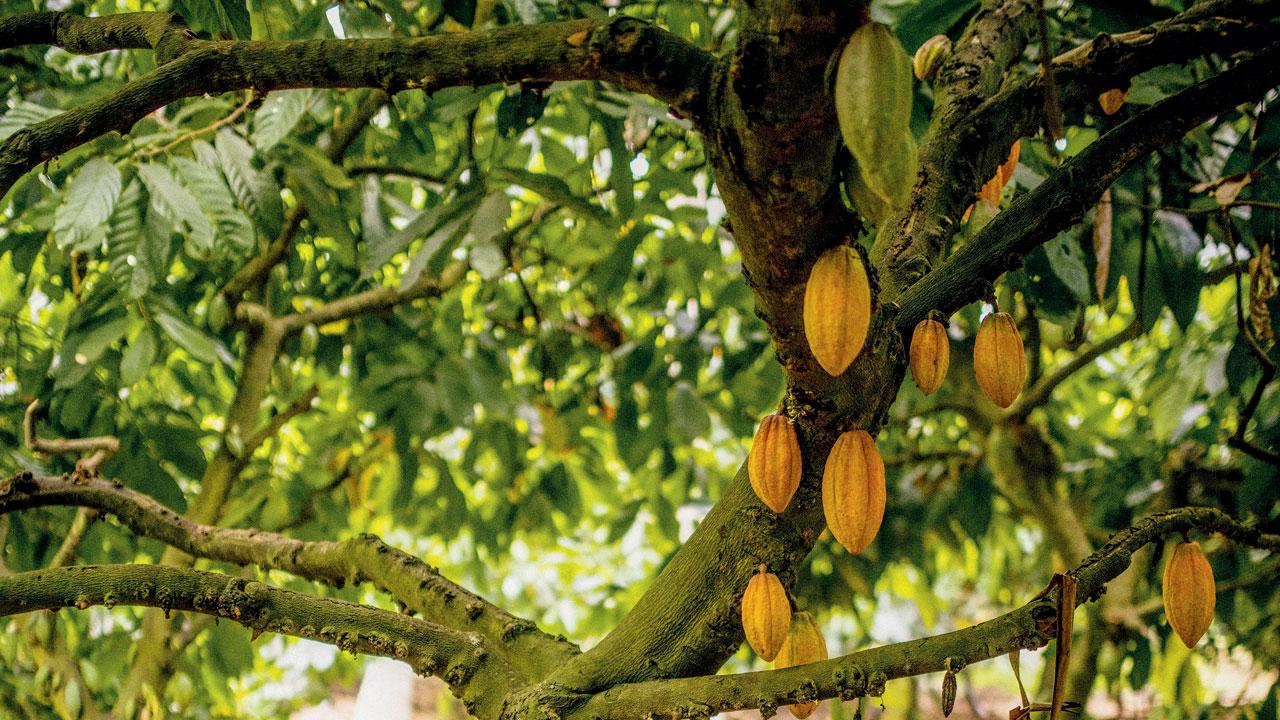On a trip to a cacao farm in West Godavari, Sunday mid day discovers limitless possibilities of the Indian bean

Staff breaks open the pods with wooden cubs to avoid damage to the beans
At 7 am, 62-year-old Boyapati Venkateswara Rao heads to his farm at Tadikalapudi, West Godavari, on his bike. About an hour ahead of Vijaywada, Rao grows coconut, cacao, palm oil, areca nut, bush pepper, agarwood, mango, and jackfruit as the main crop, using organic manure and flood irrigation on 12 acres of land.
ADVERTISEMENT
“Nature is God’s gift and farming is a beautiful way to appreciate its bounties. Multi-cropping works best for the farm and the farmers, and that is what most people in the region follow,” he tells us humbly, wearing his trademark white shirt and trousers with a red chequered cotton towel over his shoulder. On this sultry morning as we walk on the farm, we meet his eight-year-old grandson Nihal Sai as he plays with an earthworm. A Grade 3 student, he knows more about cacao farming than Google can tell us.

The five-step fermentation by experts takes eight days
July is off-season, but the theobroma cacao trees here are still laden with cacao fruits. Rao nonchalantly plucks one off the tree and breaks it open. A sitaphal look-alike, we dig into the slimy textured pulp that coats the seed and pop it in our mouth. The flavour is complex—fruity, sweet and tart, with hints of citrus, mango, and mangosteen. The bean is a bitter, astringent taste and is nothing like cacao as we know it. We are told it develops post-fermentation, and sun drying and roasting the beans gives it a further deeper, denser flavour.
As per the Directorate of Cashewnut and Cocoa Development, the West Godavari District in Andhra Pradesh is the largest cacao-growing region in India. From November till May, labour is hired once a week from 8 am to 1 pm to harvest the cacao fruits. Harvesting at the right time is critical to the cacao bean’s flavour, and eventually, that of the chocolate. Although pods mature at different times even on the same tree, unfortunately, the industrial practice is to harvest in one go.

Venkateswara Rao Boyapati
Things changed when in 2018, second-generation entrepreneur Chaitanya Muppala went on a search for quality Indian chocolate. He learned the difference between industrial and craft chocolate, which led him to create a business model for fine flavour Indian craft chocolate. Subsequently, in 2021, he incorporated Distinct Origins Private Limited to establish the West Godavari region as a place of origin from where potential global craft chocolate makers could import fine flavour cacao beans. They joined hands with Rao and 100 other progressive farmers in the region to form a collective and share global best-industry practices with them.
“Now, our labourious and time-intensive process involves carefully cutting each tree-ripened pod at the peak of flavour, adhering to stringent harvest protocols,” he says. “This allows us to care about the long-term health of cacao trees, soil and the land. We make a clean cut through the tree stalk with a pruning hook without damaging the flowering area, from which potential future pods will grow. An over-ripe pod means it will start to germinate and won’t be ideal for use. We detect optimal ripeness by the cacao pod’s colour and sound. The pod changes colour from red to green to purple and eventually, yellow when it is ready for harvest. We also tap the pod to listen for loose seeds inside, indicating that it is ripe for picking.”

Rao has been irrigating his farm with flood irrigation for about eight years, “as it ensures all layers of the soil get water and the roots are well nourished. In this region, for over a hundred years, we have been depending on ponds for farming. About 10 years ago, we followed drip irrigation with The Polavaram Project (an under-construction multi-purpose irrigation project on the Godavari River in the Eluru District and East Godavari District), but I noticed the yield was low, and I switched to flood irrigation. With the Pattiseema Lift Irrigation Project, a river interlinking project that connects the Godavari to Krishna River, water comes to our pond through canals to support drip irrigation from November to May. I learnt about irrigation on my own and have observed that with flood irrigation, yield is better, plants are colourful, quality, taste, flavour, the colour of the fruits are perfect.”
During off-season, like now, the staff picks coconuts fallen off the trees. “Dropped coconuts have more minerals and nutrients. We use them in various forms,” he adds while coming out with a tray of jaggery-laced coconut chips for us to munch on. Not too far from the farm is Distinct Origins Cacao Fermentery, a state-of-the-art cacao processing facility built inside a former tobacco warehouse where harvested pods are opened within 24 hours to prevent fermentation. The discarded husks are converted to vermicompost and put back to work to replenish the soil’s nutrients. The fermentary is the largest of its kind in India and is estimated to be the second largest in the world.
“India has been growing cacao for over six decades, says Muppala, “yet we are not known for fine-flavoured cacao. Instead, our cacao has an unappealing flavour, with sharp acidic notes, thanks to rudimentary fermentation and careless drying methods, harsh sun and volatile temperatures. Both fermentation and drying are crucial in bringing out the inherent flavours of cacao but the farmers lack resources, infrastructure, and time. So we decided to take control of this step—instead of buying processed beans from farmers, the company buys the fruit and processes it at the fermentary, taking the load off member farmers, giving them the time and energy to focus on nurturing their crops.” Muppala has also been conducting extensive experiments to revolutionise the fermentation and drying processes of Indian cacao through scientific interventions and proprietary technology.
At the fermentary, a stringent process is in place for cacao screening to ensure that no raw, exposed, or damaged pods enter the system. The pods are opened using wooden clubs so as to not damage the seeds, and fermentation is a five-step process overlooked by skilled fermenters. During the eight-day-long process, the beans and their sweet pulp are placed in wooden sweat boxes, lined with banana leaves and covered with jute bags to maintain temperature and moisture levels. The pulp provides the sugar for fermentation while the banana leaves contain natural yeast and microorganisms that help kickstart the process. The bean is then slow-dried on movable racks (alternating between sun and shade) to remove excess moisture without losing the flavour. Post careful sorting and grading, it is vaccum packed in 20 kg batches for ease of transport, especially for craft chocolatiers, and ready to go to the market.
 Subscribe today by clicking the link and stay updated with the latest news!" Click here!
Subscribe today by clicking the link and stay updated with the latest news!" Click here!







